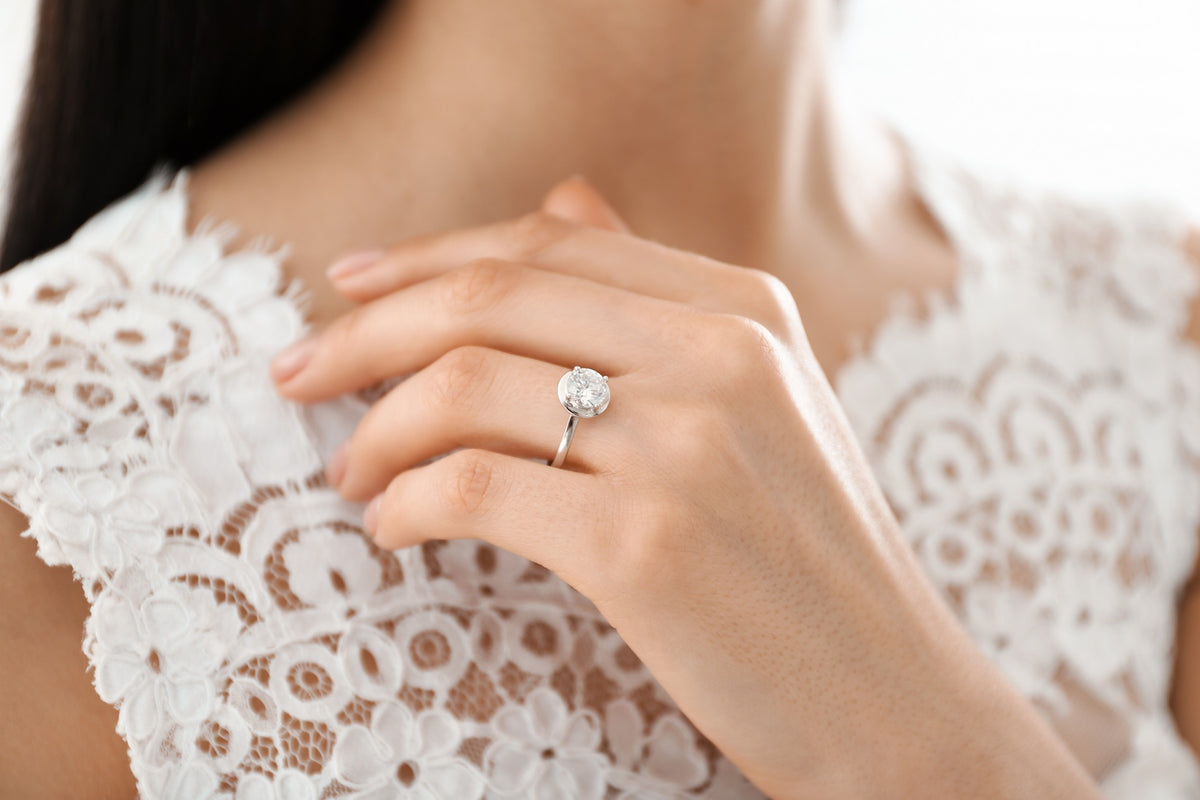Nothing sets memory in motion like taking a tour through your jewelry box. Handling a bracelet your favorite aunt passed down to you, or a ring given to you by a first love, reminds us of the feeling of slipping on a beautiful piece and finding it feels like it was made just for you.
So how do you figure out your ring size to replicate that same experience when you’re giving a ring to yourself?
Most of us can intuit when a ring fits sheerly by its feel. But if you want to get the perfect fit time and again, there are several techniques you should know to find a ring that feels like it was destined for your finger.
5 Ways to Find Ring Size At Home
Finding the right size is one of the most important steps of the custom jewelry process. Most of us can spot a ring that fits by its feel: It’s secure but not too snug, and it’s faithful to your finger (instead of twirling around on it). A well-fitting-ring should also:
- Glide over your knuckle easily
- Require some mild force to take off
- Never pinch or dig into your skin
- Never pull at the skin or require excessive exertion to remove
When you can’t try rings on at a jewelry designer’s brick-and-mortar shop, there are 5 methods you can use to find your true size.
#1 Use a Ring Size Chart
If you’ve got a printer at home, you can start to measure ring size online by using a ring size chart—simple as hitting “download” and “ctrl+P.” All you’ll need to do is print the ring sizer and lay a ring you already own against the circles. If your ring is smaller or larger than the provided circles, go for the half-size between them.
For this method, you’ll want to make sure your chart prints according to true dimensions. Before calculating your ring size, ensure the ruler illustrations were printed at their intended proportions.
#2 Calculate Your Ring Size
If you’re investing in a big-ticket or highly meaningful ring, you’ll want to measure your finger’s circumference and match it up with the correct size on a US ring sizing chart.
While the process is straightforward, you’d be surprised how easy it can be to make micro-mistakes while measuring—any of which can drastically affect the ultimate fit of your piece! Here are 3 tips for avoiding those minor mishaps and finding your accurate size:
- Choose the right measuring materials – Get your hands on a wrappable material you’ll be able to manipulate easily. You can use twine or a shoelace if you’re in a pinch, but for easy measuring, you’re best off reaching for a soft measuring tape. Just avoid using elastic materials like hair ties or rubber bands—these can stretch when wrapped around a finger, which can cause you to underestimate your ring size.
- Know which finger to measure – Choose the finger that you intend to wear the ring on. In some people, even the same digit on separate hands can be a bit differently sized—so if you know the piece will be worn on one hand more than the other (e.g., like a ring!), be sure you measure the appropriate finger.
- Pick the ideal time of day – Just as the same finger on different hands could have slight deviations in size and fit, fingers can switch their size throughout the day. Fluid retention and rising and falling temperatures can all make micro-adjustments to a finger’s apparent size. For the ideal fit, aim to size in the middle of the day rather than in the morning or evening.
And, as a general rule, if you find yourself in-between sizes, you’re best off gravitating to the next size up.
#3 Invest in A Ring Sizer Tool
If you’re wondering how to get ring sizes like a professional, there are several tools available for achieving expert-level measurements at home:
- Ring Sizer Set ($4.99) – You’ll usually see ring sizer sets in plastic or metal. They look like a key ring with several loops that correspond to each standard ring size. When you try them on, just be sure you’re matching your perfect loop to the US (not the UK!) size if your ring was designed in America.
- Ring Sizer Zip Tie ($3.99) – These devices look like a cross between a ruler and a zip tie. You’ll wrap it around your finger and tighten it until you’ve achieved a fit that feels comfortable for you. Then, you’ll cross-reference your measurement size chart.
- Ring Mandrel ($6 to $16) – A mandrel is what a professional jeweler would use to measure your true ring size. These look like long, tapered metal rods with sizes marked along the length. If you already have a ring that fits your finger well, you can use a mandrel to easily find its size: just slide your ring onto the length until it stops.
A more affordable method is to use a printable ring sizer to determine your finger size. A quick Google search can help you find a printable ring sizer.
#4 Use the Finger Size Estimation Trick
Looking at a ring size guide can still be confusing. Fortunately, you need not rely on a measuring tape to measure your ring size. You can estimate your ring finger size based on your other fingers.
While it’s obvious that thumbs and pinkies can come in vastly different sizes, but did you know most people’s fingers have similar proportions compared with other fingers?
Generally speaking, where the ring finger is size X, your other four fingers size at the following proportions:
- Pinky finger: 2 sizes less than X
- Middle finger: ½ size larger than X
- Pointer finger: 1 size larger than X
- Thumb: 1 size larger than X
#5 Try a Ring Size App
In the 21st century, you can also try a ring sizing app, which lets you discover your size with your phone. These apps work like a printable ring size chart, where you’ll lay a favorite fitted ring on your phone's screen (rather than a print-out).
The advantage of ring size apps is that many of them can convert your size to standards from around the world. If you’re eyeing a piece designed outside your own country, this may be the best method for you.
How Is Ring Size Determined?
Different countries adhere to their own regional standards for sizing and manufacturing. For instance, in many European countries, ring sizes are set by the International Organization for Standardization (ISO), which designates size by a piece’s inner circumference in millimeters. If you’re shopping around for engagement rings in Paris, you’ll find sizes fall between 49 (15.6mm) and 72 (22.9mm).1
However, in the US, Canada, and Mexico, we use our own scale for specifying ring size. American designs come in 22 standard sizes, from 3 (the smallest) to 13.5 (the largest). With each graduating size, a ring’s inner circumference expands by approximately .4 millimeters.
The majority of designers offer women’s rings in sizes 4 to 10. Sizes 5 through 7 are the most common, weighing in with the following circumferences:2
- Size 5 – 15.6 millimeters
- Size 5.5 – 16 millimeters
- Size 6 – 16.45 millimeters
- Size 6.5 – 16.9 millimeters
- Size 7 – 17.3 millimeters
These measurements represent the average ring size for women. But, if you fall outside of standard ring sizing, many designers can create customized rings to help you achieve a perfect fit.
Should I Have My Rings Sized Professionally?
If you’re not comfortable determining your ring size alone, you can always seek out the help of a seasoned local jeweler. They’ll be able to measure your finger(s) with top industry tools, as well as provide advice about design features that can influence the fit and feel of a ring. These include:
- Knuckle size
- Band width
- Setting type
Your jeweler is also a good resource for ring cleaning, resizing, and regular maintenance to keep your favorite pieces looking like new.
What To Do If Your Ring Is The Wrong Size
If you order a ring online and you find it doesn’t fit quite right, many companies offer the option to resize or exchange the piece. However, resizing options usually depend on several factors:
- Ring style – Certain styles of rings aren’t easily resized. Eternity bands are typically not eligible for resizing since the stones are set carefully and evenly around the entire band. If it were to be resized, any adjustments could affect its structural integrity (and overall value).
- Ring material – Some specialty metals like stone, titanium, and stainless steel are best ordered once you know your ring size. The properties of these materials are too difficult to adjust.
- Ring size – Rings can usually be sized a maximum of 2 sizes up or down. If your purchased piece falls out of this range, you’ll have to exchange it for a larger or smaller model.
Additionally, some companies’ return, exchange, and resizing policies may be more limited if the piece is custom-made. If you’re inclined to add your own touches to your ring, seek out a company that offers generous resizing policies for both custom and designer styles.
Following these steps can help you customize wedding rings or an engagement ring. And most of them are easy enough to do that you can learn how to find ring size at home.
Find Your Perfect Fit With Noémie
At Noémie, we believe every jewelry purchase should feel like adding a new treasure to your trove. Our timeless fine jewelry is handcrafted with conflict-free gems, enduring integrity, and room to play with the design of your dreams.
Whether you’re browsing engagement rings or building a custom band, your chosen piece should fit you perfectly—in shape, feel, and style. That’s why we provide complimentary, seamless returns and exchanges, and complimentary resizing services for every piece.
Ultimately, you deserve to love your ring for as long as it was meant to last: forever. Start getting inspired to find your next treasure by shopping our enchanted collections today.
Sources:
- International Organization for Standardization. ISO 8653:2016 – Jewellery — Ring-sizes — Definition, measurement and designation. https://www.iso.org/standard/65408.html
- Real Simple. How To Measure Your Ring Size at Home. https://www.realsimple.com/beauty-fashion/shoes-accessories/jewelry/how-to-measure-ring-size

